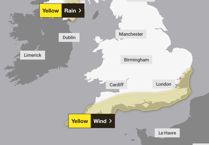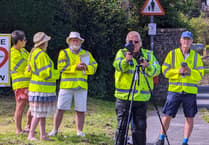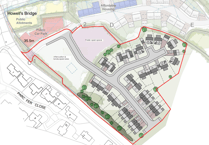HALWILL JUNCTION was a place that for most of its operational life had something of an identity crisis.
Upon its opening on January 28, 1879, it was known as Beaworthy, before becoming Halwill and Beaworthy a mere few months later in July 1879.
Less than a year after becoming a junction station on July 21, 1886, it would lose the Beaworthy moniker which had been part of its name since the beginning, becoming Halwill Junction, later becoming simply Halwill in January 1923. Although, for those not quite sure where it goes, a large running in board helpfully declared “Halwill for Beaworthy, junction for the Bude, North Cornwall, and Torrington lines”.
The mixed identities of Halwill largely were borne of its origins and what it would later become, for as a railway station, its particular location was relatively nondescript in terms of its proximity to major population centres.
Being located between the villages of Halwill and Beaworthy, it was for this reason for the first years of its life, it bore the names of both, but by the turn of a century, much like at the bluntly named ‘Camelford Station’ and ‘Otterham Station’ further down the North Cornwall line, communities had grown around the railway stations which were a distance outside of the communities they initially intended to serve. Indeed, although extremely little remains of Halwill Junction as a railway station, the name of the area still serves as a reminder of what it once was.
While it might not have been particularly notable or important as a railway station in its own right, where Halwill Junction came into its own was for its role as the central interchange between the different lines that formed the ‘Withered Arm’ – the former London and South Western Railway (LSWR), later Southern Railway routes west of Exeter.

It was at Halwill Junction that the erstwhile trainspotter of years gone by would witness the dividing of the legendary and lengthy Atlantic Coast Express into different portions to go to different areas, with sections of the previously linked together coaches venturing to Bude or further down the line towards Padstow and Wadebridge.
Comprising of four platforms, of which two were through platforms and two were bay platforms, the size and scale of Halwill Junction grew as the LSWR continued to build more lines into new communities previously untouched by the railway revolution. Although, it wasn’t until 1925 that it reached its full form, coinciding with the shortening of the name simply to ‘Halwill’.
After the arrival of the railways in the area in January 1879 as part of the extension of the LSWR line from Meldon Junction on the Okehampton to Plymouth line to Holsworthy, which would itself later provide a connection to the long-delayed Bude branch, Halwill became a junction in 1886 upon being connected with the nascent North Cornwall Railway to Launceston, eventually reaching Wadebridge in 1895. Bude followed on August 10, 1898, with Padstow connected to the line on March 23, 1899. By 1914, the daily service on the line consisted of six down trains to Padstow, one to Launceston, and nine to Bude with five services from Padstow and eight from Bude in the up direction.
The final connection to Halwill Junction came a little over two decades later, on July 27, 1925, when a third route on the North Devon and Cornwall Junction Light Railway stretched out towards Torrington.
While the railway heyday for many stations is often described as the early part of the 20th century with the rise of the tourism industry, it is perhaps ironic that despite its vital role in providing connectivity to the parts of the network popular with holidaymakers, the time which Halwill was at its most busy was at a time that began its downfall; World War II.
It was during the war that eight additional sidings were added to the site at Halwill Junction to deal with the military traffic leading up to the decisive D-Day. It was also a place where the Railway Howitzer could be sighted, a rail-mounted artillery weapon.
The economic damage caused to the United Kingdom by the war, including to the railway infrastructure itself, saw the railways nationalised after World War II, with the formation of British Railways. With the advent of the motor car snatching a large amount of the railway traffic that once connected through Halwill Junction towards Bude, Padstow, Wadebridge, and Torrington drying up, it was perhaps unsurprising that come the Beeching Report of 1963 it was slated for closure. In the preceding years, services had begun to be reduced, with only four trains over the North Cornwall Line to Padstow each day, one as far as Launceston, and eight trains a day to Bude, two of which started at Halwill.

Originally, Halwill Junction was slated for the chopping block in April 1964, and although given a reprieve, it was one that was to be short-lived as the once-integral junction saw a slow, elongated death with the services it once connected to being obliterated one by one.
First, on March 1, 1965, the Torrington line that had only been in existence for 40 years was permanently discontinued, with the connections to Bude and Padstow over the North Cornwall Railway coming to an end the following year on October 3, 1966, a delay on the proposed date of December 22, 1965, believed to be due to problems sourcing replacement bus services for the routes lost.
The final, temporary timetable covering the period until its demise in 1966, featured a miserly three trains a day from Halwill to Wadebridge, of which two would go onto Padstow.
The closure of Halwill Junction by virtue of the loss of its connecting lines saw the demise of the line enthusiasts still refer to as this day as the Withered Arm. There is very little left of what was once the railway junction and station, for the vast majority of it has been redeveloped; although the Junction Inn, a pub close to the location of the former level crossing and where a gradient marker still remains with photos of the stations’ former life inside the venue.
Standing near to the site of the station is a housing estate, perhaps ironically named after the man who recommended the area’s railway demise; with Beeching Close a reference to Dr Richard Beeching. The station building itself was left derelict before being demolished in the mid-to-late 1980s.
Near to Halwill, a section of trackbed still exists in the form of a nature reserve, after the Devon Wildlife Trust purchased a section of land on the former track bed from British Rail and a private landowner in 1990. Later in the 1990s, Devon County Council enabled a cycleway to cross the site, with this being realised in 2005.
A vision to create a Camel Trail-esque multi-use pathway on the section east to Meldon Junction, however, hit the buffers when after the agreement in principle by Devon County Council to create a bridleway on an intact disused section of the Bude branch from Thorndon Cross to Halwill was met with objections from local residents and extortionate prices demanded from owners of the former trackbed land.




